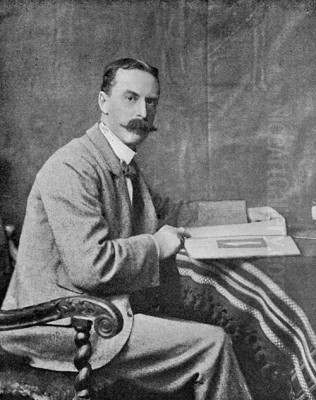
Edmund Blair Leighton stands as a prominent figure in the landscape of British art during the late Victorian and Edwardian periods. Born in London on September 21, 1852, he carved a distinct niche for himself as a painter specializing in historical genre scenes, particularly those evoking the romance and chivalry of the medieval era and the refined elegance of the Regency period. Though he operated slightly outside the official circles of the Royal Academy establishment, his meticulously crafted, emotionally resonant, and visually splendid canvases earned him considerable popular acclaim during his lifetime, an appreciation that continues to this day among collectors and enthusiasts of narrative painting. His work offers a captivating window into a bygone era's idealized perception of its own past.
Early Life and Artistic Formation
Edmund Blair Leighton's journey into the world of art was perhaps influenced, though not initially encouraged, by his family background. His father was the artist Charles Blair Leighton, a painter of portraits and historical subjects. Charles sadly passed away when Edmund was just two years old, leaving his upbringing largely to his mother, Caroline Leighton (née Boosey). It appears the family did not initially steer young Edmund towards an artistic career, perhaps due to the financial precariousness often associated with the profession.
He received his formal education at University College School. Upon leaving school at the age of 15, he entered the workforce, taking up a position with a tea merchant in the City of London. However, the allure of art proved irresistible. While working, Leighton dedicated his evenings to studying art at the South Kensington schools (later the Royal College of Art). His passion and dedication eventually led him to pursue art full-time.

He subsequently enrolled at the Royal Academy Schools, the prestigious training ground associated with the Royal Academy of Arts. Entering at the age of 21, he immersed himself in the rigorous academic training of the time, honing his skills in drawing, composition, and painting. It was during his time at the RA Schools that he began to define his artistic path. An early success came in 1874 when his black and white illustration, A Flaw in the Title, was accepted for exhibition at the Royal Academy's Summer Exhibition, marking the public debut of a long and prolific career. This initial work already hinted at the narrative and detailed approach that would characterize his later paintings.
The Royal Academy and Professional Career
From his debut in 1874, Edmund Blair Leighton became a remarkably consistent presence at the Royal Academy's Summer Exhibitions. For over four decades, from 1878 until 1920, just two years before his death, he submitted works almost annually. The Royal Academy was the premier venue for artists in Britain, and regular exhibition there was crucial for establishing a reputation and securing patronage. Leighton's ability to consistently have his work accepted speaks volumes about the quality of his craft and its appeal to the selection committees and the public alike.
His paintings, often depicting poignant moments of farewell, romantic encounters, or scenes of quiet domesticity set in meticulously researched historical settings, struck a chord with Victorian and Edwardian audiences. They offered an escape into idealized worlds, rich in detail, sentiment, and narrative suggestion. His subjects ranged from the medieval period, filled with knights and fair ladies, to the elegance of the early 19th century Regency era.
Despite this sustained presence and popularity, Leighton never achieved the official accolades of being elected an Associate of the Royal Academy (ARA) or a full Royal Academician (RA). This is somewhat curious given his consistent exhibition record and public favour. It might reflect a subtle divergence between popular taste and the internal politics or shifting aesthetic priorities of the Academy itself during a period that saw the rise of Impressionism and Post-Impressionism, styles far removed from Leighton's polished academic finish. Nonetheless, his lack of official RA status did little to diminish his success or the enduring appeal of his work.
Artistic Style and Thematic Focus
Edmund Blair Leighton's style is firmly rooted in the academic tradition of the 19th century, characterized by a high degree of finish, meticulous attention to detail, and a strong emphasis on narrative clarity. He was a historical genre painter, meaning he depicted scenes of everyday life, anecdotes, or specific moments, but set them in historical periods, primarily the Middle Ages and the British Regency. His approach was distinctly romanticized; he wasn't aiming for gritty historical realism but rather an idealized, often nostalgic, vision of the past.
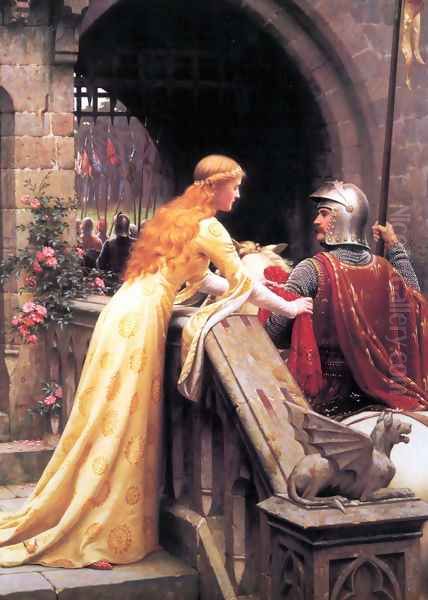
His canvases are notable for their careful rendering of textures – the gleam of armour, the richness of velvet, the solidity of stone architecture. Costume and setting were researched with care to provide an air of authenticity, even if the overall mood was one of romance rather than strict historical accuracy. His compositions are typically well-structured and balanced, guiding the viewer's eye towards the central narrative moment. Colour is often rich and jewel-like, enhancing the decorative quality of his work.
While sometimes compared loosely to the Pre-Raphaelites for his interest in medieval themes and detailed finish, Leighton's style lacks the intense symbolism and moral earnestness of painters like Dante Gabriel Rossetti or William Holman Hunt. His work is closer in spirit, perhaps, to contemporaries like John William Waterhouse, who also explored romantic and mythological themes with a similar polished technique, or Lawrence Alma-Tadema, known for his incredibly detailed depictions of classical antiquity, albeit with a different subject focus. Leighton carved his own path, focusing on chivalry, courtship, and moments of quiet human drama within these historical frameworks.
Key Themes: Chivalry and Medieval Romance
A significant portion of Edmund Blair Leighton's oeuvre is dedicated to the world of medieval knights, castles, and courtly love. This fascination with the Middle Ages was a widespread phenomenon in Victorian Britain, fueled by literature, revivalist architecture, and a yearning for a perceived simpler, more heroic past. Leighton tapped into this sentiment masterfully, creating some of his most iconic and enduring images within this genre.
His paintings often focus on moments charged with emotion and narrative potential. Departures and farewells are common themes, allowing him to explore duty, love, and uncertainty. God Speed (1900) is a prime example, depicting a knight in full armour receiving a token from his beloved lady tied to his arm as he prepares to ride out through the castle gate. The woman's gaze follows him, a mixture of pride and apprehension, encapsulating the romantic ideal of the loyal lady and the valiant knight.
Another celebrated work, The Accolade (1901), portrays the solemn ceremony of knighthood. A young queen or noblewoman touches the shoulder of a kneeling knight with a sword, conferring upon him the honour. The scene is imbued with a sense of ritual, reverence, and idealized femininity and masculinity. Leighton's skill in rendering the textures of armour, fabric, and stone, combined with the dramatic lighting, makes this a particularly compelling image. These works, and others like them, cemented Leighton's reputation as a leading painter of chivalric romance.
Key Themes: Regency Elegance and Genre Scenes
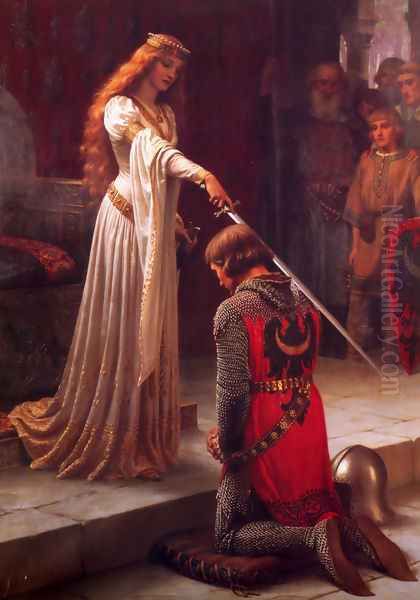
Alongside his medieval subjects, Edmund Blair Leighton frequently turned his attention to the British Regency period (roughly 1811-1820) and the immediately succeeding decades. These paintings capture a different kind of romance – one of refined manners, elegant costumes, formal gardens, and drawing-room encounters. This era, popularized by authors like Jane Austen, held its own nostalgic appeal for Victorian audiences, representing a time of perceived grace and social order.
In works like Signing the Register (date uncertain, but exhibited RA 1899), Leighton depicts a wedding scene, focusing not on the grand ceremony but the intimate, legally significant moment of the couple signing the marriage register in a vestry. The attention to the details of early 19th-century dress, the interior setting, and the quiet interaction between the figures creates a charming and relatable historical vignette. It showcases his ability to find narrative interest in less overtly dramatic moments.
Another example might be What shall I say? (exhibited RA 1899), which likely portrays a moment of contemplation or decision within a social context typical of the period. These Regency paintings allowed Leighton to explore different aspects of costume, interior design, and social customs, demonstrating his versatility within the historical genre. They possess a gentler, more domestic charm compared to the heroic drama of his medieval scenes, but share the same commitment to detailed rendering and evocative atmosphere.
Meticulous Technique and Craftsmanship
A defining characteristic of Edmund Blair Leighton's art is his exceptional technical skill and meticulous craftsmanship. His paintings exhibit a high level of finish, meaning the brushwork is often smooth and blended, allowing for precise detail and a polished surface. This approach was highly valued within the Academic tradition, which emphasized draftsmanship and careful execution over visible brushstrokes or impressionistic effects.
Leighton paid extraordinary attention to the accurate depiction of historical details. Whether rendering the intricate patterns on a suit of armour, the delicate lace on a Regency gown, the specific architectural features of a medieval castle, or the furnishings of a period room, his commitment to verisimilitude was paramount. This required considerable research and a deep understanding of historical costume, architecture, and artifacts. This dedication to detail lends his paintings a sense of authenticity and visual richness that greatly appealed to his audience.
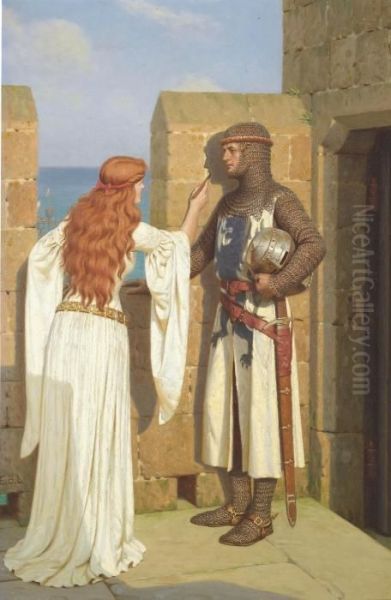
His compositions are carefully constructed, often using architectural elements or landscape features to frame the figures and focus attention on the narrative core. He employed light and shadow effectively to create mood and highlight key elements within the scene. While his style might be seen as conservative compared to the avant-garde movements emerging during his career, the sheer quality of his execution earned him respect. His work stands as a testament to the enduring appeal of skilled representational painting and narrative clarity, reminiscent of the high standards set by earlier academic painters like his namesake (though unrelated) Frederic, Lord Leighton, or the detailed historical reconstructions of James Tissot.
Notable Works Explored
Several of Edmund Blair Leighton's paintings have achieved iconic status and exemplify his artistic concerns and stylistic strengths.
The Accolade (1901): Perhaps his most famous work, it depicts the moment a kneeling knight is dubbed by a noble lady or queen. The composition is strong, the lighting dramatic, focusing on the central figures. The rendering of the knight's armour and the lady's gown is exquisite. The painting perfectly encapsulates the ideals of chivalry, honour, and the romanticized relationship between knight and lady.
God Speed (1900): Another highly popular image, showing a lady tying her favour to her knight's arm as he departs for war or a quest. The emotion of farewell is palpable. The detailed depiction of the castle gate, the horse, and the armour adds to the scene's historical atmosphere. It speaks to themes of love, duty, and separation.
The Shadow (1909): This poignant work shows a couple standing by a sundial. The man, possibly a soldier or knight, points towards the shadow cast by the sundial's gnomon, perhaps indicating the passage of time or an impending departure. The woman looks down thoughtfully. The painting is believed to be inspired by the ancient Greek story of Debutades, who traced her lover's shadow on a wall before he left, considered one of the origin myths of painting. It evokes themes of love, time, memory, and loss.
Signing the Register (exhibited 1899): A charming Regency-era scene capturing the quiet, intimate moment of a newly married couple signing the official church register. It highlights Leighton's skill in depicting period costume and interiors, and in conveying subtle human interactions.
Lady Godiva (exhibited 1892): Tackling a famous historical legend, this painting is housed in the Leeds Art Gallery. It showcases Leighton's ability to handle historical narratives, likely depicting the noblewoman before or after her legendary ride through Coventry.
Witness my Act and Seal (exhibited 1898): The title suggests a legal or formal moment, perhaps involving documents and seals, likely set in a historical context that allowed for rich costume and setting details. Reproductions of this work indicate its popularity.
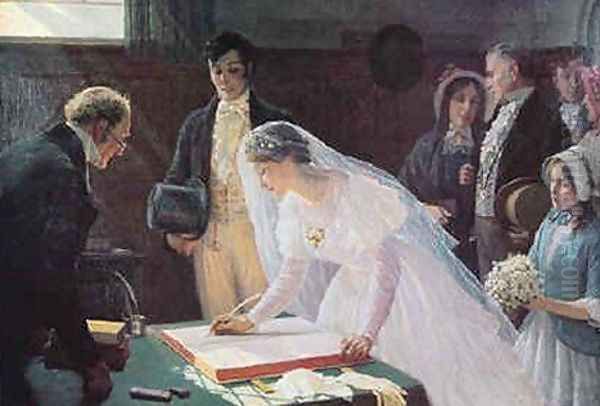
These works, among many others, demonstrate Leighton's consistent focus on narrative, his technical prowess, and his ability to evoke romanticized historical moods that resonated strongly with his audience.
Influences and Contemporaries
Edmund Blair Leighton's artistic development was shaped by various factors. His father, Charles Blair Leighton, provided an early, albeit brief, exposure to the life of an artist. His formal training at the Royal Academy Schools grounded him in the academic techniques of the time. While specific tutors are not often highlighted, the general influence of the RA's curriculum, emphasizing drawing from the antique and life models, was crucial. Some sources suggest an admiration for the masters of the Italian Renaissance, such as Michelangelo, Giotto, and Donatello, whose influence might be seen in the clarity of composition and narrative force. A later influence from the Dutch artist Becker has also been noted in some analyses of his work.
He worked during a vibrant period in British art. While distinct from the Pre-Raphaelite Brotherhood (whose key figures included Sir John Everett Millais, Dante Gabriel Rossetti, and William Holman Hunt), Leighton shared their interest in historical and literary themes and detailed execution, though his style was generally less symbolic and intense. He was a contemporary of the highly successful and influential Frederic, Lord Leighton (President of the Royal Academy from 1878 to 1896). Although they shared a surname and exhibited at the same institution, they were not related. Edmund's work, while polished, generally lacked the classical grandeur and scale often seen in Frederic Leighton's major canvases.
Other contemporaries whose work shares some thematic or stylistic affinities include Lawrence Alma-Tadema, with his meticulous historical reconstructions; John William Waterhouse, known for his romantic depictions of mythological and Arthurian subjects; Frank Dicksee, who also painted scenes of chivalry and romance; George Frederic Watts and Edward Burne-Jones, leading figures of the later Symbolist-influenced aesthetic movement; James Tissot, a master of detailed Victorian genre scenes; and Arthur Hacker, another successful academic painter of the era. Leighton navigated this rich artistic landscape, developing his own recognizable style focused on accessible historical romance.
Personal Life
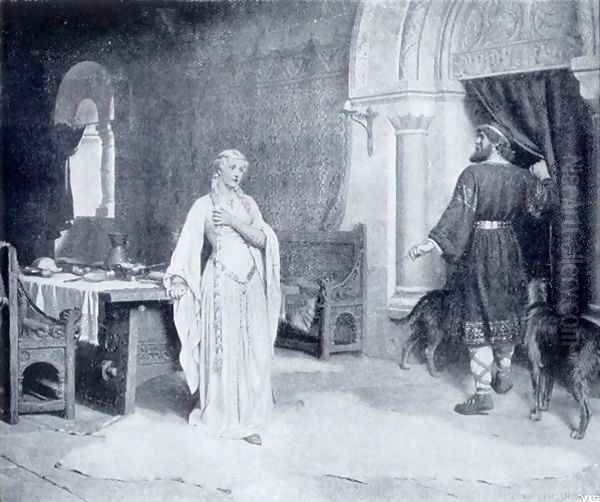
Beyond his prolific artistic career, details of Edmund Blair Leighton's personal life are less documented than his professional activities. We know he married Katherine Nash in 1885. The couple had two children: a son, Edmund James Blair Leighton, who followed in his father's footsteps and also became a painter, exhibiting works at the Royal Academy; and a daughter, whose name is less frequently recorded in standard biographies.
Leighton appears to have been a dedicated professional, maintaining a studio in London (initially in Percy Street, later moving to Bedford Park) and consistently producing work for the annual exhibitions. Anecdotes suggest a man with a sense of humour, as evidenced by the story of him nicknaming a bat "Fat Belle." Another anecdote, perhaps revealing a more flirtatious side, recounts him saying he would kiss local women if forced to leave Oxford. These glimpses suggest a personality perhaps less reserved than the often formal or dramatic subjects of his paintings might imply. He lived and worked through a period of significant social and cultural change, yet his art remained focused on idealized visions of the past. He passed away on September 1, 1922, leaving behind a substantial body of work.
Legacy and Reception
During his lifetime, Edmund Blair Leighton enjoyed considerable popularity. His paintings were frequently reproduced as prints, making his images accessible to a wider audience beyond the gallery-going public. The narrative appeal, romantic sentiment, and meticulous detail of his work struck a chord with Victorian and Edwardian tastes. While he may not have received the official honours of RA membership, his consistent presence at the Academy exhibitions and the demand for his work indicate significant commercial success and public appreciation.
After his death, like many Victorian academic painters, his reputation waned somewhat during the ascendancy of Modernism, which often dismissed narrative and highly finished representational art. However, in recent decades, there has been a resurgence of interest in Victorian painting, and Leighton's work has found renewed appreciation. His paintings now command respectable prices at auction, as seen with works like What shall I say? appearing at auction houses such as Bram Auctions and Bonhams.
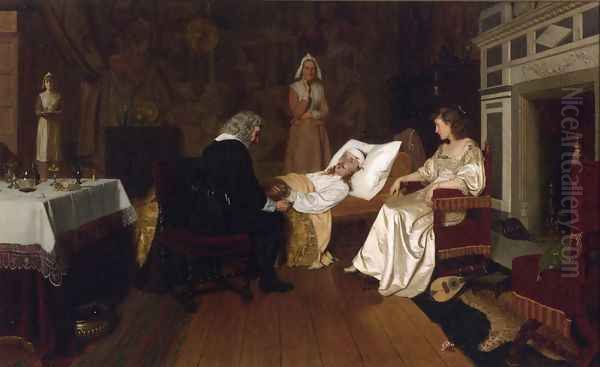
His works are held in public collections, such as Lady Godiva in Leeds Art Gallery, though many remain in private hands, a testament to their desirability among collectors then and now. While the Leighton House Museum in London is primarily dedicated to Frederic, Lord Leighton, the shared name sometimes causes confusion; Edmund Blair Leighton's legacy rests firmly on his own distinct body of work. He remains recognized as a skilled and appealing painter of historical genre, a master craftsman whose romantic visions of the past continue to captivate viewers.
Conclusion
Edmund Blair Leighton occupies a significant place in the story of late British Victorian and Edwardian art. As a dedicated historical genre painter, he brought to life idealized visions of the medieval and Regency past, focusing on themes of chivalry, romance, and poignant human moments. His work is characterized by meticulous craftsmanship, a high degree of finish, careful attention to historical detail (particularly in costume and setting), and a strong narrative sensibility.
Though never elected to the highest ranks of the Royal Academy, he was a constant and popular exhibitor there for over forty years, his paintings finding favour with the public and collectors alike. Works like The Accolade, God Speed, and The Shadow have become enduring images, frequently reproduced and admired for their technical skill and evocative power. While influenced by the academic tradition and working alongside contemporaries like Waterhouse, Alma-Tadema, and Dicksee, Leighton developed a distinctive voice. His legacy lies in his contribution to the romantic historical genre, offering beautifully rendered escapes into worlds of honour, elegance, and sentiment that continue to hold appeal today.